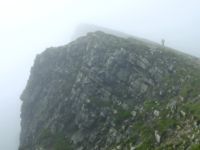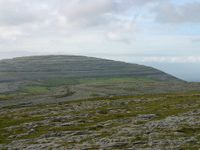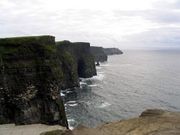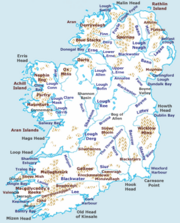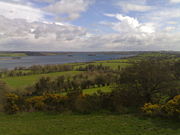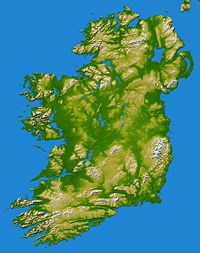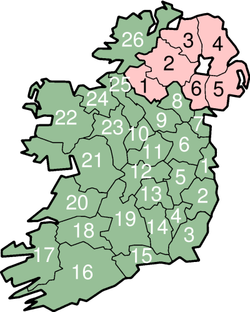Geography of Ireland
2008/9 Schools Wikipedia Selection. Related subjects: European Geography
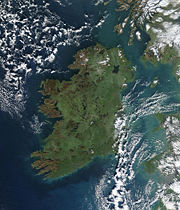
The geography of Ireland describes an island in northwest Europe in the north Atlantic Ocean. The main geographical features of Ireland include low central plains surrounded by a ring of coastal mountains. The highest peak is Carrauntoohil ( Irish: Corrán Tuathail), which is 1,041 metres (3,414 ft) above sea level. The western coastline is rugged, with many islands, peninsulas, headlands and bays. The island is bisected by the River Shannon, which at 259 km (161 s) with a 113 km (70 miles) estuary is the longest river in the British Isles and flows south from County Cavan in Ulster to meet the Atlantic just south of Limerick. There are a number of sizeable lakes along Ireland's rivers, with Lough Neagh being the largest.
Politically, the island consists of the state of the Republic of Ireland and the United Kingdom constituent country Northern Ireland. Located west of the island of Great Britain, it is located at approximately . It has a total area of 84,412 km² (32,591 mile²). It is separated from Britain by the Irish Sea and from mainland Europe by the Celtic Sea.
Geological development
The oldest known Irish rock is about 1.7 billion years old and is found on Inishtrahull Island off the coast of County Donegal. In other parts of Donegal, scientists have discovered rocks that began life as glacial deposits, demonstrating that at this early period, part of what was to become Ireland was in the grip of an ice age. However, because of the effects of later upheavals, it is almost impossible to sequence these early rock layers correctly.
About 600 million years ago, at the end of the Precambrian era, the Irish landmass was divided in two, with one half on the western side of the Iapetus Ocean and the other at the eastern side, both at about the latitude that of around 80° South, close to what is now northwest Africa. From the evidence of fossils found at Bray Head in County Wicklow, Ireland was below sea level at this time.
Over the next 50 million years, these two parts drifted towards each other, eventually uniting about 440 million years ago. Fossils discovered near Clogher Head, County Louth, show the coming together of shoreline fauna from both sides of the original dividing ocean. The mountains of northwest Ireland were formed during the collision, as was the granite that is found in locations in Donegal and Wicklow. The Irish landmass was now above sea level and lying near the equator, and fossil traces of land-based life forms survive from this period. These include fossilised trees from Kiltorcan, County Kilkenny, widespread bony fish and freshwater mussel fossils and the footprints of a four-footed amphibian preserved in slate on Valentia Island, County Kerry. Old Red Sandstone also formed at this time.
Between 400 million and 300 million years ago, northwest Europe – including Ireland – sank beneath a warm, calcium-rich sea. Great coral reefs formed in these waters, eventually creating the limestone that still makes up about 65 per cent of the rock mantle of the island. As the waters receded, tropical forests and swamps flourished. The resulting vegetable debris eventually formed coal, most of which was later eroded. This period, known as the Carboniferous era, ended with further tectonic movement which saw Ireland drift further northward. The resulting pressure created those Irish mountain and hill ranges that run in a northeast to southwest direction.
By 250 million years ago, Ireland was at the latitude of present-day Egypt and had a desert climate. It was at this time that most of the coal and sandstone were eroded. The thinner layers of limestone in the south of the country were also partially affected by this erosion. The limestone that was exposed by the disappearance of its sandstone mantle was affected by carbon dioxide and other factors resulting in a karstic landscape that can still be seen in the Burren in County Clare. Shortly after this period, organic debris in the seas around Ireland began to form the natural gas and petroleum deposits that now play an important role in the economy of Ireland. Then, about 150 million years ago, Ireland was again submerged, this time in a chalky sea that resulted in the formation of chalk over large parts of the surface. Traces of this survive under the basalt lava that is found in parts of the north.
About 65 million years ago, the volcanic activity that formed this lava began. The Mourne Mountains and other mountains in the northern part of the island formed as a result of this activity. Climatic conditions at this time were warm and vegetation thrived. Vegetable debris in the Antrim depression formed deposits of brown coal or lignite which remain untouched down to the present time. The warm conditions produced high rainfall that accelerated processes of erosion and the formation of karstic landscape forms.
By 25 million years ago, Ireland was close to assuming its present position. The long period of erosion had resulted in considerable soil formation and most of the rock mantle was covered. In areas with good drainage, the covering consisted of brown or grey soil, while in poorly drained areas the black clay tended to dominate. As the climate cooled, soil formation slowed down, and a flora and fauna that would, millions of years later, be familiar to the first human inhabitants began to emerge. By about three million years ago, the present landscape of Ireland had more or less formed.
Since about 1.7 million years ago, the earth has been in the grip of a cycle of warm and cold stages and these have, inevitably, affected Ireland. The earliest evidence we have for this effect comes from the period known as the Ballylinian Warm Stage, some half a million years ago. At this time, most of what are now considered to be native Irish trees were already established on the island. The action of the ice during the cold stages was the major factor in bringing the Irish landscape to its current form.
Obvious impacts of the ice on the landscape include the formation of glacial valleys such as Glendalough in Wicklow and of corries, or glacial lakes. The depositing of mounds of debris under the melting ice created drumlins, a common feature of the landscape across the north midlands. Streams also formed under the ice and the material deposited by these formed eskers ( Irish eiscir). The greatest of these, the Esker Riada, divides the northern and southern halves of the island and its ridge once served as the main highway connecting the east and west coasts. About one half of the coastline consists of a low lying dune pasture land known as Machair.
Rocks and soil types
The large central lowland is of limestone covered with glacial deposits of clay and sand, with widespread bogs and lakes. The Bog of Allen is one of the largest bogs. The coastal mountains vary greatly in geological structure. In the south, the mountains are composed of old red sandstone with limestone river valleys. In Galway, Mayo, Donegal, Down and Wicklow, the mountains are mainly granite, while much of the northeast of the country is a basalt plateau. An area of particular note is the Giant's Causeway, in Antrim, a mainly basalt formation caused by volcanic activity between 50–60 million years ago. The basalts were originally part of the great Thulean Plateau formed during the Paleogene period.
The soils of the north and west tend to be poorly drained peats and gleys, including peaty podzols. In contrast, in the south and east the soils are free-draining brown earths and brown and grey-brown podzols. This is reflected in the rainfall distribution on the island, with the poorly-drained regions being those with the highest rainfalls.
An unusual environment is present in north County Clare, in an area known as the Burren. This karst-like landscape consists of limestone bedrock, with little or no soil in the inner-most areas. There are numerous sinkholes, where surface water disappears through the porous rock surface, and extensive cave systems have been formed in some areas. The Pol an Ionain cave, near Doolin, is the site of one of the world's longest known free-hanging stalactites.
Mountain ranges
Ireland consists of a mostly flat low-lying area in the midlands, ringed by mountain ranges such as (beginning in County Kerry and working counter-clockwise) the Macgillycuddy's Reeks, Comeragh Mountains, Blackstairs Mountains, Wicklow Mountains, the Mournes, Glens of Antrim, Sperrin Mountains, Bluestack Mountains, Derryveagh Mountains, Ox Mountains, Nephinbeg Mountains and the Twelve Bens/ Maumturks group. Some mountain ranges are further inland in the south of Ireland, such as the Galtee Mountains, the highest inland range, Silvermines and Slieve Bloom Mountains. The highest peak is Carrauntoohil, 1,041 m (3,414 ft) high, is in the Macgillycuddy's Reeks, a range of glacier-carved sandstone mountains in County Kerry, in the southwest of the island. The mountains are not high – only three peaks are over 1,000 m (3,281 ft) and another 457 exceed 500 m (1,640 ft).
Rivers and lakes
The main river in Ireland is the River Shannon, 386 km (240 miles), the longest river in either Ireland or Great Britain, which separates the boggy midlands of Ireland from the West of Ireland. The river develops into three lakes along its course, Lough Allen, Lough Ree, and Lough Derg. Of these, Lough Derg is the biggest. The River Shannon enters the Atlantic Ocean after Limerick city at the Shannon Estuary. Other major rivers include the River Liffey, River Lee, River Blackwater, River Nore, River Suir, River Barrow, River Erne, and River Boyne. (See the list of rivers in Ireland.)
Lough Neagh, in Ulster, is the biggest lake in the British Isles. Legend has it that a giant, Fionn mac Cumhail, was fighting with another in Scotland, and enraged, scooped out a lump of earth, which he threw. It fell into the Irish Sea, creating the Isle of Man, while the hole filled up with water to become Lough Neagh. Other large lakes include Lough Erne and Lough Corrib.
Inlets
Beginning with County Donegal, Lough Swilly separates one side of the Inishowen peninsula. Lough Foyle on the other side, is one of Ireland's larger inlets, situated between County Donegal and County Londonderry. Further round the coast is Belfast Lough, between County Antrim and County Down. Also in County Down is Strangford Lough, actually an inlet partially separating the Ards peninsula from the mainland. Further down the coast, Carlingford Lough is situated between Down and County Louth.
Dublin Bay is the next sizable inlet, while the eastern coast of Ireland is mostly uniform until Wexford Harbour at the mouth of the River Slaney. On the southern coast, Waterford Harbour is situated at the mouth of the River Suir (into which the other two of the Three Sisters ( River Nore and River Barrow) flow). The next major inlet is Cork Harbour, at the mouth of the River Lee, in which Great Island is situated.
Dunmanus Bay, Bantry Bay, Kenmare estuary and Dingle Bay are all inlets between the peninsulas of County Kerry. North of these is the Shannon estuary. Between north County Clare and County Galway is Galway Bay. Clew Bay is located on the coast of County Mayo, south of Achill Island, while Blacksod Bay is north of the island. Killala Bay is on the north coast of Mayo. Donegal Bay is a major inlet between County Donegal and County Sligo.
Headlands
Malin Head is the most northerly point in Ireland, while Mizen Head is one of the most southern points, hence the term "Malin head to Mizen head" (or the reverse) is used for anything applying to the island of Ireland as a whole. Carnsore Point is another extreme point of Ireland, being the southeasternmost point of Ireland. Further along the coast is Hook Head while the Old Head of Kinsale in is one of many headlands along the south coast of Ireland.
Loop Head is the headland at which County Clare comes to a point on the west coast of Ireland, with the Atlantic on the north, and further inland on the south, the Shannon estuary. Hags Head is another headland further up Clare's north/western coastline, with the Cliffs of Moher along the coastline north of the point.
Erris Head is the northwesternmost point of Connacht.
Islands and peninsulas
Achill Island, in the northwest, is the largest island off Ireland's coast. The island is inhabited, and is connected to the mainland by a bridge. Some of the next largest islands are the Aran Islands, off the coast of southern Connacht, host to an Irish-speaking community, or Gaeltacht. Valentia Island off the Iveragh peninsula is also one of Ireland's larger islands, and is relatively settled, as well as being connected by a bridge at its southeastern end. Omey Island, off the coast of Connemara is a tidal island.
Some of the best-known peninsulas in Ireland are in County Kerry; the Dingle peninsula, the aforementioned Iveragh peninsula and the Beara peninsula. The Ards peninsula is one of the larger peninsulas outside Kerry. The Inishowen Peninsula includes Ireland's most northerly point, Malin Head and several important towns including Buncrana on Lough Swilly, Carndonagh and Moville on Lough Foyle. Ireland's most northerly land feature is Inishtrahull island, off Malin Head. Rockall Island may deserve this honour but its status is disputed, being claimed by the United Kingdom, Republic of Ireland, Denmark (for the Faroe Islands) and Iceland. The most southerly point is the Fastnet Rock.
Climate
Ireland's climate is temperate, though significantly warmer than almost all other locations at similar latitude, such as Poland (on the continent) or Newfoundland (on the opposite edge of the Atlantic), due to the warming influence of the North Atlantic drift. The prevailing wind blows from the southwest, breaking on the high mountains of the west coast. Rainfall is therefore a particularly prominent part of western Irish life, with Valentia Island, off the west coast of County Kerry, getting almost twice as much annual rainfall as Dublin on the east (1400 mm vs. 762 mm). Across the country, about 60% of the annual rainfall occurs between August and January.
January and February are the coldest months of the year, and mean daily air temperatures fall between 4 and 7 °C during these months. July and August are the warmest, with a range of 14 to 16 °C. The sunniest months are May and June, with an average of five to seven hours sunshine per day. Though extreme weather events in Ireland are comparatively rare when compared with other countries in the European Continent, they do occur. Explosive Atlantic depressions, occurring mainly in the months of December, January and February, can occasionally bring winds of up to 160 km/ph (100 mph) to Western coastal counties; while the summer months, and particularly around late July/early August, sudden and violent thunderstorms can develop, more especially, but not exclusively, across midland and western areas of the country.
The table shows mean climate figures for the Dublin Airport weather station over a thirty-year period. Climate statistics based on the counties of Northern Ireland vary slightly but are not significantly different.
| Dublin Airport weather station statistics from 1961 to 1990 | |||||||||||||
| Factor | Jan | Feb | Mar | Apr | May | Jun | Jul | Aug | Sep | Oct | Nov | Dec; | Year |
|---|---|---|---|---|---|---|---|---|---|---|---|---|---|
| Mean daily max temp (°C) | 7.6 | 7.5 | 9.5 | 11.4 | 14.2 | 17.2 | 18.9 | 18.6 | 16.6 | 13.7 | 9.8 | 8.4 | 12.8 |
| Mean daily min temp (°C) | 2.5 | 2.5 | 3.1 | 4.4 | 6.8 | 9.6 | 11.4 | 11.1 | 9.6 | 7.6 | 4.2 | 3.4 | 6.0 |
| Mean daily sunshine (h) | 1.8 | 2.5 | 3.6 | 5.2 | 6.1 | 6.0 | 5.4 | 5.1 | 4.3 | 3.1 | 2.4 | 1.7 | 3.9 |
| Mean monthly rain (mm) | 69.4 | 50.4 | 53.8 | 50.7 | 55.1 | 56.0 | 49.9 | 70.5 | 66.7 | 69.7 | 64.7 | 75.6 | 732.7 |
Political and human geography
Ireland is divided into four provinces, Connacht, Leinster, Munster and Ulster, and 32 counties. Six of the nine Ulster counties form Northern Ireland and the other 26 form the Republic of Ireland. The map shows the county boundaries for all 32 counties.
From an administrative viewpoint, 20 of the counties in the Republic are units of local government. The other six have more than one local authority area, producing a total of 34 county-level authorities. Tipperary has two parts, North Tipperary and South Tipperary. The cities of Dublin, Cork, Limerick, Galway and Waterford have city councils and are administered separately from the counties bearing those names. The remaining part of County Dublin is split into Dun Laoghaire-Rathdown, Fingal, and South Dublin.
Electoral areas in the Republic of Ireland, called constituencies in accordance with Irish law, mostly follow county boundaries. Maintaining links to the county system is a mandatory consideration in the re-organisation of constituency boundaries..
In Northern Ireland, a major re-organisation of local government in 1973 replaced the six traditional counties and two county boroughs (Belfast and Derry) by 26 single-tier districts, which, apart from Fermanagh cross the traditional county boundaries. The six counties and two county-boroughs remain in use for purposes such as Lieutenancy. In November 2005, proposals were announced which would see the number of local authorities reduced to seven. The island's total population of approximately 6 million people is concentrated on the east coast, particularly in Dublin and Belfast and their surrounding areas.
